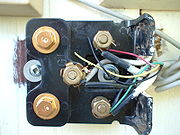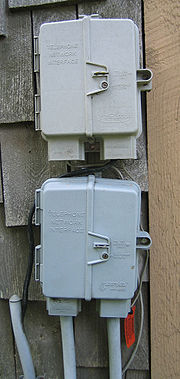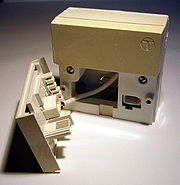
Demarcation point
Encyclopedia

Telephony
In telecommunications, telephony encompasses the general use of equipment to provide communication over distances, specifically by connecting telephones to each other....
, the demarcation point is the point at which the public switched telephone network
Public switched telephone network
The public switched telephone network is the network of the world's public circuit-switched telephone networks. It consists of telephone lines, fiber optic cables, microwave transmission links, cellular networks, communications satellites, and undersea telephone cables, all inter-connected by...
ends and connects with the customer's on-premises wiring
On-premises wiring
In telecommunication, on-premises wiring is customer-owned communications transmission lines. It is also called customer premises wiring . The transmission lines can be metallic or optical fiber, and may be installed within or between buildings.Premises wiring may consist of horizontal wiring,...
. It is the dividing line which determines who is responsible for installation and maintenance of wiring and equipment -- customer/subscriber, or telephone company
Telephone company
A telephone company is a service provider of telecommunications services such as telephony and data communications access. Many were at one time nationalized or state-regulated monopolies...
/provider. The demarcation point varies between countries and has changed over time.
Demarcation point is sometimes abbreviated as demarc, DMARC, or similar. The term MPOE (minimum or main point of entry) is synonymous, which the added implication that it occurs as soon as possible upon entering the customer premises. A network interface device
Network interface device
In telecommunications, a Network Interface Device is a device that serves as the demarcation point between the carrier's local loop and the customer's premises wiring....
often serves as the demarcation point.
History
Prior to the Bell System divestitureBell System divestiture
The Bell System divestiture, or the breakup of AT&T, was initiated by the filing in 1974 by the U.S. Department of Justice of an antitrust lawsuit against AT&T. The case, United States v...
on January 1, 1984, American Telephone & Telegraph Company (AT&T) through its Bell System
Bell System
The Bell System was the American Bell Telephone Company and then, subsequently, AT&T led system which provided telephone services to much of the United States and Canada from 1877 to 1984, at various times as a monopoly. In 1984, the company was broken up into separate companies, by a U.S...
companies held a natural monopoly
Natural monopoly
A monopoly describes a situation where all sales in a market are undertaken by a single firm. A natural monopoly by contrast is a condition on the cost-technology of an industry whereby it is most efficient for production to be concentrated in a single form...
for telephone service within the United States. AT&T owned the local loop
Local loop
In telephony, the local loop is the physical link or circuit that connects from the demarcation point of the customer premises to the edge of the carrier or telecommunications service provider's network...
, including the telephone wiring within the customer premises
On-premises wiring
In telecommunication, on-premises wiring is customer-owned communications transmission lines. It is also called customer premises wiring . The transmission lines can be metallic or optical fiber, and may be installed within or between buildings.Premises wiring may consist of horizontal wiring,...
and the customer telephone equipment. A similar arrangement existed with smaller, regional telephone companies such as GTE
GTE
GTE Corporation, formerly General Telephone & Electronics Corporation was the largest independent telephone company in the United States during the days of the Bell System....
. As a result of deregulation of the telephone system, unbundling
Local loop unbundling
Local loop unbundling is the regulatory process of allowing multiple telecommunications operators to use connections from the telephone exchange to the customer's premises...
of the local loop, and lawsuits by companies wishing to sell third-party equipment
Hush-a-Phone v. FCC
Hush-A-Phone v. United States, 238 F.2d 266 was a seminal ruling in United States telecommunications law decided by the D.C. Circuit Court of Appeals. Hush-A-Phone Corporation marketed a small, cup-like device which mounted on the speaking party's phone, reducing the risk of conversations being...
to connect to the telephone network, there was a need to delineate the portion of the network which was owned by the customer and the portion owned by the telephone company or the common carrier
Common carrier
A common carrier in common-law countries is a person or company that transports goods or people for any person or company and that is responsible for any possible loss of the goods during transport...
. Where the portions meet is called the demarcation point.
Canada

Extension (telephone)
An extension telephone is an additional telephone wired to the same telephone line as another. In middle 20th century telephone jargon, the first telephone on a line was a "Main Station" and subsequent ones "Extensions". Such extension phones allow making or receiving calls in different rooms,...
join to connect to the network. This junction block usually includes a lightning arrestor (which requires a wire to earth ground.) In multi-line installations such as businesses or apartment buildings, the demarcation point may be a punch down block. In most places this hardware existed before deregulation.
United States

Federal Communications Commission
The Federal Communications Commission is an independent agency of the United States government, created, Congressional statute , and with the majority of its commissioners appointed by the current President. The FCC works towards six goals in the areas of broadband, competition, the spectrum, the...
rules (47 C.F.R. Part 68) to allow safe connection of third-party telephone Customer-premises equipment
Customer-premises equipment
Customer-premises equipment or customer-provided equipment is any terminal and associated equipment located at a subscriber's premises and connected with a carrier's telecommunication channel at the demarcation point...
and wiring to the Public Switched Telephone Network
Public switched telephone network
The public switched telephone network is the network of the world's public circuit-switched telephone networks. It consists of telephone lines, fiber optic cables, microwave transmission links, cellular networks, communications satellites, and undersea telephone cables, all inter-connected by...
(PSTN).
The modern demarcation point is the network interface device
Network interface device
In telecommunications, a Network Interface Device is a device that serves as the demarcation point between the carrier's local loop and the customer's premises wiring....
(NID). The NID is the telco's property. The NID may be outdoors (typically, mounted on the building exterior in a weatherproof box) or indoors.
The NID is usually placed for easy access by a technician. It also contains a lightning arrestor, fuse
Fuse (electrical)
In electronics and electrical engineering, a fuse is a type of low resistance resistor that acts as a sacrificial device to provide overcurrent protection, of either the load or source circuit...
and test circuitry which allows the carrier to remotely test whether a wiring fault lies in the customer premises or in the carrier wiring, without requiring a technician at the premises. The demarcation point has a user accessible RJ-11 jack (a "test jack" or "demarcation jack"), which is connected directly to the telephone network, and a small loop of telephone cord connecting to the jack by a modular connector
Modular connector
Modular connector is the name given to a family of electrical connectors originally used in telephone wiring and now used for many other purposes. Many applications that originally used a bulkier, more expensive connector have now migrated to modular connectors...
. When the loop is disconnected, the on-premises wiring
On-premises wiring
In telecommunication, on-premises wiring is customer-owned communications transmission lines. It is also called customer premises wiring . The transmission lines can be metallic or optical fiber, and may be installed within or between buildings.Premises wiring may consist of horizontal wiring,...
is isolated from the telephone network and the customer may directly connect a telephone to the network via the jack to assist in determining the location of a wiring fault. In most cases, everything from the central office to and including the demarcation point is owned by the carrier and everything past it is owned by the property owner.
As the local loop becomes upgraded, with fiber optic and coaxial cable
Coaxial cable
Coaxial cable, or coax, has an inner conductor surrounded by a flexible, tubular insulating layer, surrounded by a tubular conducting shield. The term coaxial comes from the inner conductor and the outer shield sharing the same geometric axis...
technologies sometimes replacing the original unshielded twisted pair to the premises, the demarcation point has grown to incorporate the equipment necessary to interface the original premises POTS
Plain old telephone service
Plain old telephone service is the voice-grade telephone service that remains the basic form of residential and small business service connection to the telephone network in many parts of the world....
wiring and equipment to the new communication channel.
Demarcation points on houses created prior to the Bell System divestiture
Bell System divestiture
The Bell System divestiture, or the breakup of AT&T, was initiated by the filing in 1974 by the U.S. Department of Justice of an antitrust lawsuit against AT&T. The case, United States v...
usually do not contain a test jack. They only contained a spark-gap surge protector, a grounding
Ground (electricity)
In electrical engineering, ground or earth may be the reference point in an electrical circuit from which other voltages are measured, or a common return path for electric current, or a direct physical connection to the Earth....
post and mount point to connect a single telephone line. The second wire pair were usually left unconnected and were kept as a spare pair in case the first pair were damaged.
United Kingdom

In the United Kingdom, the demarcation point occurs within a jack (the master socket), whose wiring is partly owned by the customer, partly owned by the phone company. Other jacks are the customer's property. Newer NTE-5 jacks have a removable front panel: the front panel and its wiring is the customer's, while the rear wiring is BT's. The removable panel allows separation of these two parts and independent maintenance, and access to a test jack to determine whether line faults are in the customer's wiring or BT's.
See also
- Demarc extensionDemarc extensionIn telecommunications, a demarc extension is the transmission path originating from the interface of the access provider's side of a telecommunications circuit demarcation point within a premise and ending at the termination point prior to the interface of the edge Customer Premises Equipment...
- InterconnectionInterconnectionIn telecommunications, interconnection is the physical linking of a carrier's network with equipment or facilities not belonging to that network...
- Customer-premises equipmentCustomer-premises equipmentCustomer-premises equipment or customer-provided equipment is any terminal and associated equipment located at a subscriber's premises and connected with a carrier's telecommunication channel at the demarcation point...
- On-premises wiringOn-premises wiringIn telecommunication, on-premises wiring is customer-owned communications transmission lines. It is also called customer premises wiring . The transmission lines can be metallic or optical fiber, and may be installed within or between buildings.Premises wiring may consist of horizontal wiring,...
- Point of appearancePoint of appearancePoint of appearance is a generic term for any point in a telephone/data circuit from which a technician can test or pull stats. Some appearances are virtual, such as a Digital cross connect system computer terminal. Others are physical, like a punch down COSMIC frame where a technician can place a...
- Network interface deviceNetwork interface deviceIn telecommunications, a Network Interface Device is a device that serves as the demarcation point between the carrier's local loop and the customer's premises wiring....
- Main distribution frameMain distribution frameIn telephony, a main distribution frame is a signal distribution frame for connecting equipment to cables and subscriber carrier equipment . The MDF is a termination point within the local telephone exchange where exchange equipment and terminations of local loops are connected by jumper wires...
- 66 block66 blockA 66 block is a type of punchdown block used to connect sets of wires in a telephone system. 66 blocks are designed to terminate 22 through 26 AWG solid copper wire....
- 110 block110 blockA 110 block is a type of punch block used to connect sets of wires in a structured cabling system. 110 is also used to describe a type of Insulation-displacement connector used to terminate twisted pair cables which uses a similar punch-down tool as the older 66 block...
- Service termination pointService termination pointIn telecommunication, service termination point is the last point of service rendered by a commercial carrier under applicable tariffs.Usually, the service termination point is on the customer premises and corresponds to the demarcation point. The customer is responsible for equipment and operation...

